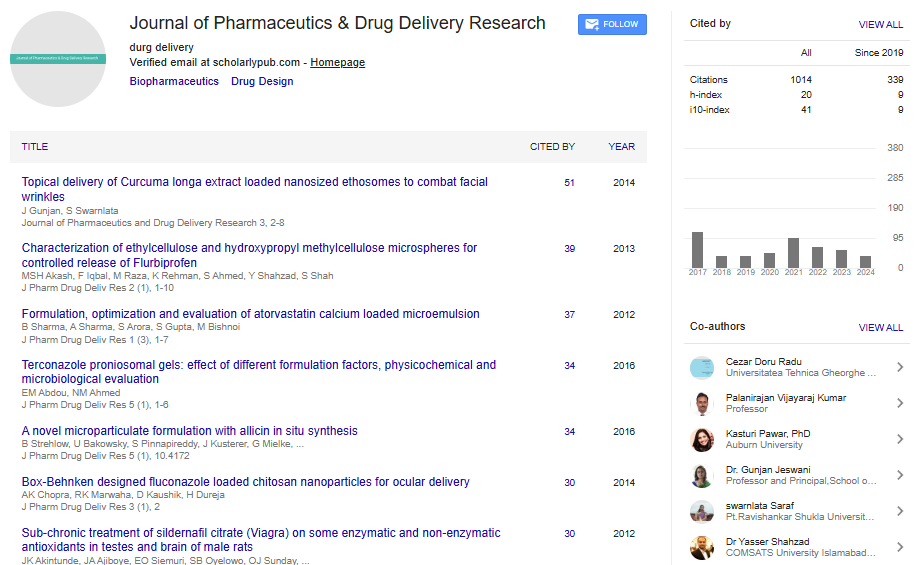Perspective, J Pharm Drug Deliv Res Vol: 13 Issue: 4
Modern Medicine is Being Revolutionized by the Techniques and Science of Drug Design
Florian Lemaitre*
1Department of Pharmaceutical Science, University Health Science Center, Beijing, China
*Corresponding Author: Florian Lemaitre,
Department of Pharmaceutical Science,
University Health Science Center, Beijing, China
E-mail: lemaitrefu78@gmail.com
Received date: 01 July, 2024, Manuscript No. JPDDR-24-145756;
Editor assigned date: 03 July, 2024, PreQC No. JPDDR-24-145756 (PQ);
Reviewed date: 17 July, 2024, QC No. JPDDR-24-145756;
Revised date: 24 July, 2024, Manuscript No. JPDDR-24-145756 (R);
Published date: 31 July, 2024, DOI: 10.4172/2325-9604.1000285
Citation: Lemaitre F (2024) Modern Medicine is Being Revolutionized by the Techniques and Science of Drug Design. J Pharm Drug Deliv Res 13:4.
Description
Drug design, often referred to as rational drug design, is the process of discovering and developing new medications based on the knowledge of a biological target. This scientific endeavor has transformed medicine, allowing for the creation of highly specific therapies that target diseases with unprecedented precision. The convergence of chemistry, biology, pharmacology and computational science has made drug design a foundation of modern therapeutic innovation.
Drug design is a multidisciplinary field that combines the principles of chemistry, biology and computational science to create molecules that can interact with specific biological targets in the body. These targets are typically proteins, enzymes, or nucleic acids that play a critical role in the progression of a disease. The goal is to design a molecule that can bind to the target with high affinity and specificity, thereby modulating its activity in a way that is therapeutically beneficial.
Traditionally, drug discovery was a serendipitous process, often involving the screening of natural products or chemical libraries to identify compounds with desirable biological activity. This approach, while successful in many cases, was time-consuming and inefficient. In contrast, rational drug design is a more systematic and knowledgedriven approach. It relies on understanding the three-dimensional structure of the target and the principles of molecular interactions to design molecules that are likely to bind to the target in a specific manner.
The process begins with the identification of a biological target that is implicated in a disease. Once the target is identified, its structure is studied in detail, often using techniques like X-ray crystallography or Nuclear Magnetic Resonance (NMR) spectroscopy. Computational tools are then used to model how potential drug molecules might interact with the target, allowing scientists to design molecules that are optimized for binding to the target.
One of the most significant advancements in drug design has been the incorporation of computational techniques. These methods allow scientists to simulate the interaction between a drug and its target, predict the drug's behavior in the body and optimize its structure for better efficacy and safety.
Molecular docking is one such technique, where a computer program predicts the preferred orientation of a drug molecule when it binds to its target. This helps in understanding the interaction at the molecular level and in designing drugs that can bind more effectively. Another important technique is Quantitative Structure-Activity Relationship (QSAR) modeling, which correlates the chemical structure of a compound with its biological activity. QSAR models are used to predict the activity of new compounds before they are synthesized, saving time and resources in the drug development process.
Despite the advancements, drug design is fraught with challenges. One of the primary challenges is the complexity of biological systems. A drug that works well in a test tube may not behave the same way in the human body, where it must navigate a complex environment and interact with many other molecules. Additionally, off-target effects, where a drug interacts with unintended targets, can lead to adverse side effects.
Another challenge is the emergence of drug resistance, particularly in the context of infectious diseases and cancer. Pathogens and cancer cells can evolve to become resistant to drugs, rendering them ineffective. This requires a continuous effort to design new drugs that can overcome resistance mechanisms.
Moreover, the growing field of biopharmaceuticals, which includes biologics such as monoclonal antibodies and gene therapies, is expanding the scope of drug design beyond traditional small molecules. These therapies are designed to target diseases at a molecular level, offering the potential for more effective and personalized treatments.
 Spanish
Spanish  Chinese
Chinese  Russian
Russian  German
German  French
French  Japanese
Japanese  Portuguese
Portuguese  Hindi
Hindi 
